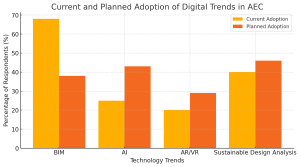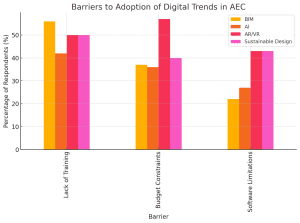The Architecture, Engineering, and Construction (AEC) industry is undergoing a significant transformation, driven by technological advancements and increasing demands for efficiency and sustainability
The Digital technology trends in the AEC industry 2025 report explores the adoption, challenges, and expectations surrounding key digital trends in the industry.
The study is based on a survey of 520 AEC professionals, primarily from small firms (50 employees or fewer) across 49 countries. The four main technology trends analysed are:
- Building information modelling (BIM)
- Artificial intelligence (AI)
- Augmented reality/virtual reality (AR/VR)
- Sustainable design analysis
Key findings of the report
- 62.5% of respondents plan to adopt at least one of these trends in the next five years, while 37.5% do not plan to adopt any.
- The biggest barrier to adoption across all technologies (except AR/VR) was lack of training.
Every trend is expected to become more widespread in the next decade. - BIM is the most adopted technology currently and delivers the highest ROI.
- AI has the highest expected growth rate over the next ten years.
- Sustainable Design Analysis is already widely used, with strong future adoption rates.

Adoption rates of digital trends in AEC:
- Shows the current adoption rates alongside planned adoption rates for BIM, AI, AR/VR, and Sustainable Design Analysis.
- BIM is currently the most widely adopted technology, while AI has the highest planned adoption rate.

Barriers to adoption:
- Displays the top three barriers for each digital trend.
- Lack of training is the most common challenge for all except AR/VR.
- Budget constraints and software limitations are also significant barriers.
Survey results for each technology trend
Building information modelling (BIM)
BIM is the most established digital trend in the AEC industry.
- 68% of respondents have already adopted BIM, making it the most widely used trend.
- 65% of BIM adopters report it delivers the highest ROI for their practice.
- 35% of respondents have had clients request BIM integration in their projects.
- 56% of non-adopters cited lack of understanding and training as the main barrier to BIM adoption.
Future expectations:
Currently, 74.3% of respondents believe BIM is “moderately prevalent or higher”. In 10 years, 85.8% expect BIM to be “moderately prevalent or higher”.
Artificial intelligence (AI)
AI adoption in AEC is still in its early stages but is expected to grow significantly.
- 25% of respondents have already adopted AI.
- 51% rate AI as “moderately prevalent or higher” today.
- 86.2% expect AI to be “moderately prevalent or higher” in 10 years.
- AI has the lowest adoption cost, with 36% of adopters stating that no additional resources were needed.
- Only 11% of AI adopters report it currently delivers the highest ROI.
Barriers to AI adoption:
- 42% cited a lack of training.
- 36% of non-adopters stated they lack the required budget.
- 27% mentioned limited software capabilities.
Augmented reality/virtual reality (AR/VR)
AR/VR is still relatively niche, but practitioners anticipate significant growth.
- 20% of respondents have already adopted AR/VR.
- 57.1% rate AR/VR as “moderately prevalent or higher” today.
- 85.9% expect AR/VR to be “moderately prevalent or higher” in 10 years.
- 16% of adopters say AR/VR delivers the most ROI, but high implementation costs make adoption slow.
- Only 11% of adopters reported that no new resources were required for AR/VR adoption.
Barriers to AR/VR adoption:
- 57% required new software.
- 50% required new hardware.
- 50% required employee training.
- 40% needed changes in project requirements.
Sustainable design analysis
Sustainable design analysis tools help evaluate the environmental impact of AEC projects and are widely recognised as essential.
- 40% of respondents have already adopted sustainable design analysis.
- 90.7% believe it is “moderately prevalent or higher” today—second only to BIM.
- 76.3% expect sustainable design analysis to be “moderately prevalent or higher” in 10 years.
- 45.6% of non-adopters plan to adopt sustainable design analysis within the next five years, making it the most anticipated trend.
- 50% of adopters needed training to implement it.
Barriers to adoption:
- 50% of non-adopters cited lack of training.
- 43% stated limited software capabilities.
- 40% lacked the required budget.
Comparative insights
- BIM and Sustainable Design Analysis are currently the most prevalent technologies, and both are expected to maintain their dominance.
- AI is expected to experience the highest growth rate over the next decade.
- AR/VR adoption remains limited due to high implementation costs.
- Lack of training is the biggest barrier to adoption for most digital trends.
- Clients are more likely to ask about BIM and Sustainable Design Analysis than AI or AR/VR.
The AEC industry is moving towards wider adoption of digital technologies
AI is anticipated to grow rapidly, while AR/VR faces barriers related to cost and resources. The main challenge across all trends is the need for more training and industry-wide education.
Firms that fail to adopt these technologies risk falling behind, as industry expectations shift towards more digital and sustainable workflows.

